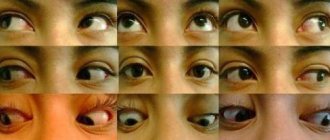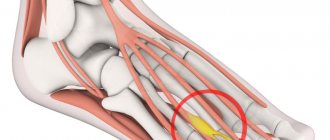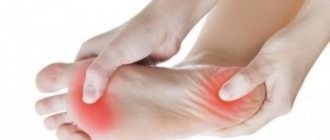Adequate sleep is a necessary condition for feeling rested and full of energy during the day. Therefore, all painful sensations and incidents during sleep can not only worsen mood and daytime performance - they reduce the quality of life. One of these fairly common phenomena is a cramp in the calf muscle during sleep.
It’s amazing: there are so many muscles in the human body, but why does the calves cramp at night, and not the muscles of the jaws or abdomen? Let's try to understand this issue.
Crump syndrome is sudden onset, painful cramps in the calf muscles.
The name “convulsions” is a misnomer, since true convulsions occur in epilepsy and episyndrome, and are accompanied by loss of consciousness or changes in it. Such a muscle spasm is not a cramp in the true sense of the word.
This is myoclonus, which, when it occurs in the calves of the legs, has a special name - crampy.
The triggering mechanism is muscle stretching, after which a sharp pain occurs and the person wakes up. For what reasons do cramp attacks occur?
Groups of provoking causes and factors
In the case of crumpy, it is important to talk about groups of causes. The following groups of provoking fatcore are clearly distinguished:
- metabolic (tetany, liver cirrhosis, gastrectomy, hypothyroidism, various electrolyte disorders can cause cramps, in addition, they appear in women during pregnancy, usually at 6-7 months);
- iatrogenic (that is, arising as a result of treatment, after diuretic therapy and hemodialysis procedures, after taking lithium, Vincristine, Labutamol, etc.);
- neurological.
It is worth saying in more detail about neurological causes; they occupy a very significant place in the pathogenesis of crampy. Such reasons include:
- amyotrophic lateral sclerosis (ALS) and other anterior horn diseases;
- complications of lumbar osteochondrosis;
- spasms caused by systemic damage to the leg muscles (for example, here we are talking about diseases such as Becker muscular dystrophy, diffuse myositis);
- quite rare, rigid person syndrome and Satoyoshi syndrome ;
- myotonic type disorders;
- d hyperactivity of motor units , syndromes and ailments associated with this.
Also, experts cite lameness, exposure to toxins on the body (insecticides, strychnine), and myalgia syndrome as separate causes. In addition, they sometimes talk about idiopathic (that is, associated with personal predisposition, the individual structure of the body) and familial (hereditary) cramps.
As we can see, there are indeed many reasons for the occurrence of crampy syndrome. And it simply won’t be possible to identify the truth at home without deep special knowledge or sophisticated diagnostic equipment.
Factors provocateurs
Generally healthy people also encounter the phenomenon of cramps (and this is more of a phenomenon than a disease). And in relation to healthy people, it is more relevant to talk not about the causes, but about the provoking factors. There are several obvious factors here:
- overheating;
- alcohol consumption and subsequent dehydration;
- prolonged muscle work, physical activity, this is relevant both for professional athletes and for ordinary physical education enthusiasts, and cramps can occur both during such exercise and after it;
- intensive and long swimming;
- seizures become more frequent during critical periods of age (for example, during adolescence);
- high losses of microelements, primarily calcium and magnesium;
- incorrect or uncomfortable position while sleeping.
Why does a cramp occur?
The causes are physiological (primary) and pathological (secondary). Relatively safe physiological causes are muscle strain, as well as temporary metabolic disorders.
In a healthy person, muscle cramps are provoked by the following factors:
- unusual long-term, high-intensity exercise;
- non-physiological muscle tension caused by diseases of the spine and joints of the limbs;
- alcohol abuse;
- insufficient sleep;
- smoking;
- violation of the temperature regime - overheating or hypothermia;
- water and electrolyte disturbances (excessive sweating in the heat, insufficient fluid intake, use of diuretics and medications);
Pathological causes of crampy are various diseases and conditions of the organs and nervous system. These include:
- diseases of peripheral nerves – radiculo- and polyneuropathy;
- Parkinson's disease;
- diseases of the central nervous system - spinal amyotrophy, amyotrophic lateral sclerosis, consequences of poliomyelitis;
- multiple sclerosis;
- liver diseases, especially chronic hepatitis and cirrhosis;
- intestinal diseases, especially viral enteritis;
- kidney disease, especially chronic renal failure with uremia;
- muscle diseases – muscular dystrophies, metabolic myopathies;
- endocrine diseases - diabetes mellitus, hypothyroidism, decreased function of the parathyroid glands;
- growth and development of tumors, benign and malignant;
- iron deficiency in the body;
- obliterating diseases of the vessels of the lower extremities;
- heart failure accompanied by edema;
- pregnancy.
Cramps can develop after blood purification operations - hemodialysis and plasmapheresis. In some cases, the cause of convulsive contractions cannot be detected; such conditions are called idiopathic.
There are familial forms when cramps occur in adolescence or old age for no apparent reason. Such forms have a wave-like course and spread to the muscles of the thighs and anterior abdominal wall. A spasm of the mylohyoid muscle is characteristic when, after yawning, its unilateral contraction develops. Researchers believe that the mechanism of hereditary transmission of this form is autosomal dominant. Many people associate cramps with a deficiency of vitamins B and D, as well as electrolytes.
Clinical picture
Crumpy usually affects the distal parts of the legs or, in other words, their lower parts. It has been noticed that the calf muscles most often suffer from cramps.
However, if a person has certain neurological diseases, convulsive conditions can occur in the facial and neck muscles, and intercostal muscles. Plus, the thighs and arms can cramp.
Crumpy occurs suddenly, the person does not feel any warning symptoms. Typically the syndrome is unilateral (meaning it affects only one leg).
In addition, studies show that in most cases, cramps are caused by “red muscles, that is, those in which the level of myoglobin is high, in which phosphorylases have low activity, and oxidative enzymes have high activity. “White” muscles have slightly different properties.
Crumpy is not characterized by any confusion or loss of consciousness, however, very severe pain is noted at the site of the spasm. And when palpated, you can detect a small compaction. In addition, even with the naked eye, deformation of the muscles can be noticeable or their contours simply appear more clearly than usual.
Convulsions in the syndrome are tonic in nature. This means that with this syndrome, twitching of the muscle or its individual segments is not noticeable.
Symptoms
Common signs of crampy syndrome are:
- sharp muscle spasm mainly in the calf area, which is unilateral;
- pronounced pain syndrome;
- upon palpation, a tense muscle is felt;
- For some time after the cessation of the spasm, aching pain bothers me.
Sometimes with crampy syndrome, fasciculations may appear. This is a condition in which contractions of muscle tissue are visible to the naked eye. It happens that visualization of a tense area can serve as a harbinger of seizures.
In people suffering from neurological diseases, spasms are more easily provoked and bother them more often. They can occur not only in the calf area, but also in the muscles of the thigh, back, chest and even face.
Cramps often appear at night, when the human body is as relaxed as possible. With existing neurological diseases, even a slight change in position can trigger the onset of painful cramps. In addition, older people are more prone to night cramps.
With Satoyoshi syndrome, on the contrary, cramps are disturbed during the daytime during any physical activity. During the spasm, the torso and limbs are forced to be fixed in an unnatural position.
With tetany in children, cramps may be accompanied by laryngeal stridor, characterized by wheezing, barking cough, and bluish discoloration of the nasolabial triangle.
Muscle spasms that appear during pregnancy indicate a lack of B vitamins, as well as microelements such as potassium and magnesium. In this case, the cramps are accompanied by general weakness, increased fatigue, and periodic discomfort in the calf muscle.
For diagnostic purposes
Diagnosis if a person complains of cramps is aimed at identifying the underlying disease. Sometimes a seizure can be provoked directly during an examination by a neurologist, for example, by squeezing the calves.
And after the initial examination, the patient may be referred for a blood test. As a result of this analysis, a biochemical profile and hormone levels are revealed. The blood is also checked for electrolyte content.
It is interesting that some types of diagnostics, for example, electromyography outside an attack of cramps, provide the doctor with zero useful information. When EMG directly records seizures, a specialist can see important changes and disturbances.
Triggering factors
Muscle cramps can often bother people suffering from not only neurological diseases.
The triggers for the appearance of spasms are:
- slow blood circulation;
- disruption of communication between organs and the central nervous system;
- vascular diseases;
- stagnation of fluid in the body;
- a lifestyle that excludes frequent physical activity.
https://www.youtube.com/watch?v=ytpressru
In addition, people who smoke and are addicted to alcohol are susceptible to cramps.
Set of measures
In order for the spasm to stop, doctors advise to massage the muscle with which the spasm occurred. The essence of the massage is to make the antagonist muscles work. By “turning on” they will stop the spasm.
If a cramp occurs while lying on the bed, you should get up and walk on the cold floor for a few minutes.
It is also recommended to eliminate provoking factors. For example, if it is noticed that a cramp occurs after certain exercises in the gym, then it is better to completely eliminate such exercises.
To relieve and reduce cramps, among other things, therapeutic exercises, contrast showers, and so-called physiotherapy are used.
Treatment of neurological causes
As mentioned above, crampy is a sign of many neurological diseases, including such serious ones as amyotrophic lateral sclerosis. With this disease, the motor neuron is affected and it is unlikely that it will be possible to stop seizures using the methods listed above.
Here you need quite powerful medications - Baclofen, Diazepam, etc. Of course, they can only be taken strictly as prescribed by a neurologist.
Let's take another similar example. Cramps become a common occurrence with complications of lumbar osteochondrosis. Consequently, all the methods and medicines that are traditionally used in the fight against this very osteochondrosis become good.
First aid for leg cramps at night
If the seizures are tonic in nature, the condition can be alleviated as follows:
- walking barefoot on a cold floor;
- take a horizontal position, stretch your leg, pull your toe towards you;
- massage the affected area;
- take aspirin to improve microcirculation in the vessels of the legs;
- for cramps of the calf muscles, a needle prick in the area of spasm is effective. The procedure must be carried out by a specialist who knows the rules of acupuncture.
- in a lying position, the lower limbs need to be raised;
- then grab your toes and bend your feet toward your knee. First, bend and release, then slowly bend and hold until the attack passes. After the procedure, the muscles are actively supplied with oxygen-enriched blood.
Folk remedies
- Lubricate the feet with grated lemon (15 days), in the morning and before bed. After drying, put socks on top.
- Rubbing with mustard oil, alcohol, apple cider vinegar, and warm compresses are also effective.
- Pine baths with sea salt are also effective.
- Light jogging for 15 minutes daily will help prevent leg cramps.
- Warming ointments are considered a proven remedy.
Is it dangerous?
Crumpies are not life-threatening. But, of course, experiencing such cramps for a long time is quite unpleasant, like any other painful sensations. The presence of such feelings in any case affects a person’s life.
And it’s unlikely that anyone will refuse to keep cramps to a minimum. If a person becomes seriously concerned about their appearance, if seizures become frequent, daily, it is worth consulting a doctor. In addition, sometimes muscle soreness after cramps persists for several days, and this is a very good reason to go to a medical facility.
It is worth adding here that cramps are almost the only clinical symptom of some neurological diseases in the early stages. But crampies themselves do not lead to them, they are only a consequence.
What causes crumpy to appear?
In addition to increased repetitive stress on certain muscle groups, existing disorders of the blood supply and innervation predispose to the development of muscle spasms. Therefore, people with obliterating atherosclerosis of the lower extremities, peripheral edema of various origins, smokers and alcohol drinkers, pregnant women with lymphatic and venous stasis in the legs are at risk for cramps.
Prolonged forced positioning of the body during pain and muscle-tonic syndrome, uneven load on the limbs lead to muscle exhaustion and contribute to the development of spasms. Therefore, people with spinal diseases, as well as those who have recently suffered injuries to the back and lower extremities, often complain about cramps.
In the presence of predisposing factors and diseases, seizures can occur not only during physical activity. They can be triggered by passive muscle stretching, stretching, turning over in sleep, or hypothermia.
For prevention purposes
To prevent muscle spasms that accompany pain, experts recommend muscle stretching exercises. One of these exercises is quite simple.
To perform it, a person needs to stand about a meter from the wall. Then you need to lean forward to touch the wall. In this case, the feet should not be lifted off the floor for a second. You need to stay in this position for about five seconds, then you need to return to the starting position. It is recommended to do such exercises three to four times a day for five minutes.
Another effective preventive measure is exercise on an exercise bike. This is especially true for those who move little and lead a sedentary lifestyle.
Doctors also call wrapping your feet in a blanket while sleeping and consuming enough water per day for your body as preventive measures.
In addition, those who want to protect themselves from crampy should give up alcohol, coffee and tea (or minimize their consumption), and not take, if possible, medications that provoke the syndrome.
Treatment
Therapy begins with identifying the cause that causes the periodic appearance of crampy syndrome and eliminating it with the help of medications.
https://www.youtube.com/watch?v=ytpressen-GB
The following are successfully used as auxiliary treatment methods:
- Physiotherapy.
- Water procedures.
- Intravenous administration of quinine.
- Physiotherapy.
A set of physical exercises is designed to improve muscle stretching, relieve spasms and pain. To achieve the best effect, they must be performed regularly, at least 2 times a day. To reduce the likelihood of cramps occurring at night, it is recommended to take a few minutes to exercise before going to bed.
The treatment complex includes the following exercises:
- Starting position - standing in front of a wall at a distance of about 1 m, palms resting on it at a level just above the head. Without lifting your arms and feet from the surfaces, slowly bend forward and hold the position at the maximum point of the bend for several seconds.
- The starting position is the same, only one leg needs to be bent at the knee. Without lifting your feet from the floor, slowly squat, pausing at the end point for a few seconds.
- Sit on the floor with your legs stretched forward. The task is to tilt your torso and reach your feet with your hands. Lowering your head and arching your back is prohibited.
- Rest your hands on the back of the chair. Bending your legs alternately at the knee, try to reach your buttocks with your heel.
Before performing exercises, you need to do a warm-up to warm up your muscles. On the recommendation of a doctor, this complex can be expanded.
A contrast shower brings invaluable benefits in the fight against crampy. It improves the condition of blood vessels and normalizes blood circulation.
The drug quinine causes much controversy regarding its purpose. Although effective, it has serious side effects, which is why doctors try to avoid its use.
Today, there are many physiotherapeutic methods that solve the problem of painful cramps. During the consultation process, the doctor selects the optimal and most effective treatment for each patient.
Description
Crampy syndrome is a sudden painful contraction of muscle fibers.
It can affect either part of a muscle or an entire group of nearby fibers. The pathology manifests itself in people of different ages and genders; it is believed that every second person has encountered it at least once in their life. The syndrome code according to ICD 10 is R25.225.2.
The appearance of convulsive contractions is completely unpredictable. The syndrome appears abruptly, but passes just as quickly. In most cases, it occurs after high muscular activity; people who run, swim, or jump are more predisposed to it.
The presented syndrome is not dangerous to human life and health. If it appears regularly (at least once a week), the patient should contact a doctor. Such a manifestation of Crumpy may indicate damage to the nervous system that requires urgent medical intervention.












